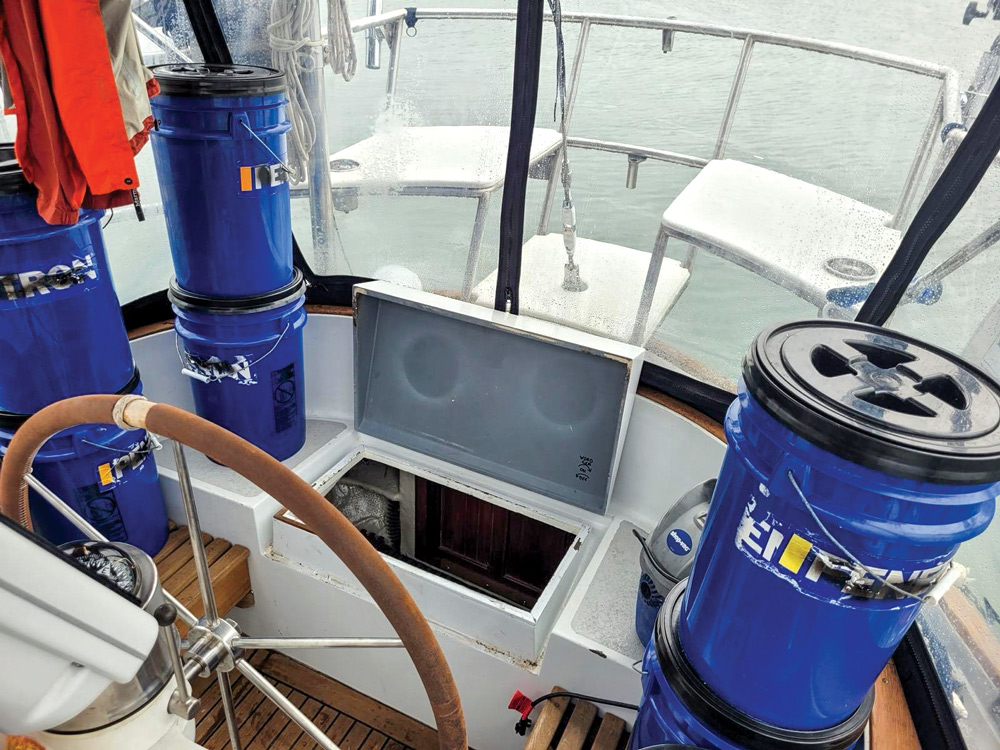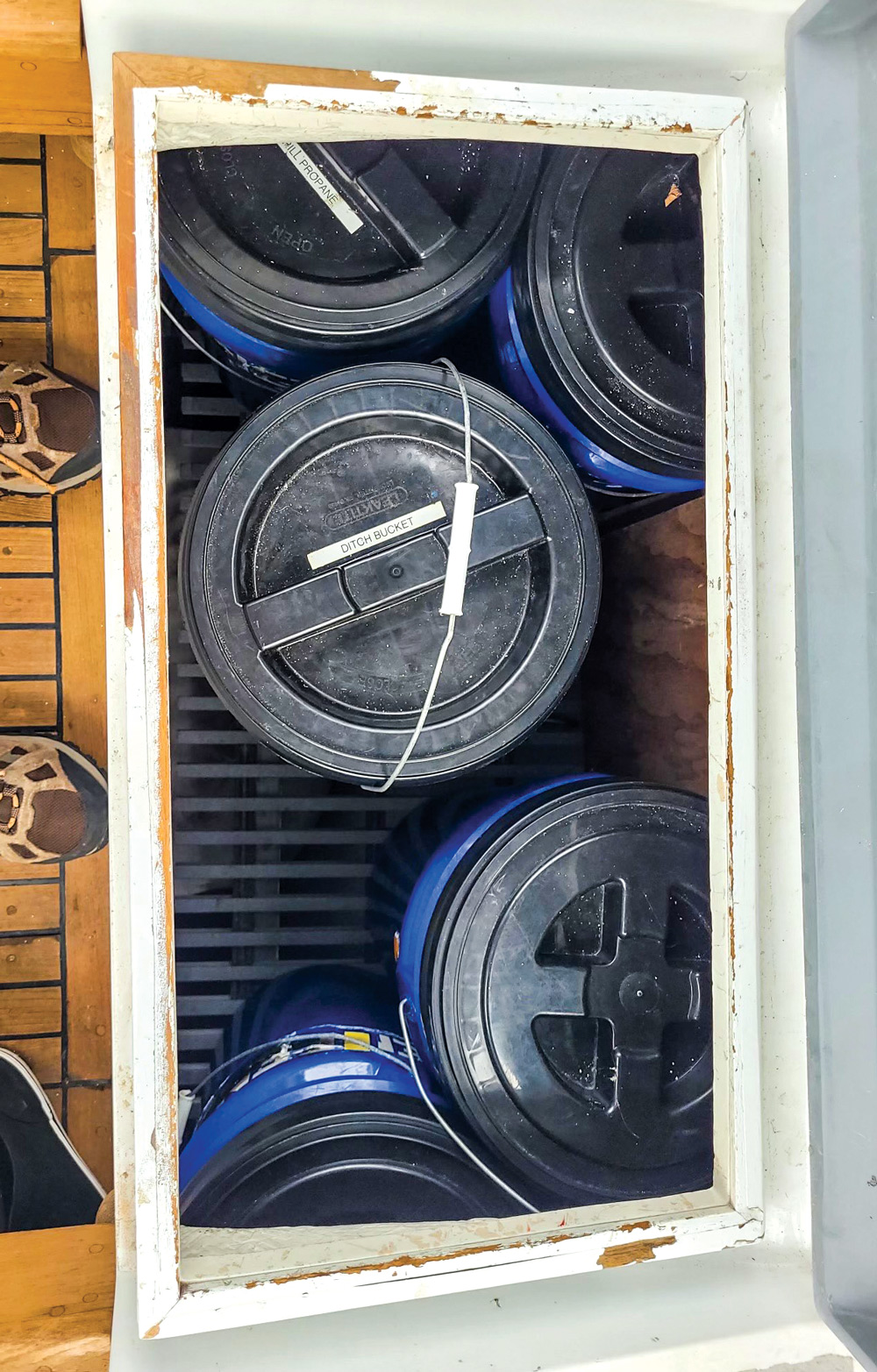The zen of onboard organization
A bucket brigade, custom solutions and regular inventory are keys for long-term cruisers
Our Passport 42, a double-ender, features a cavernous, V-shaped storage beneath the cockpit. When we first started cruising, we layered lines, dinghy supplies, storm sails, paddles, buckets of spares. We organized by weight and purported frequency of use, using hooks, bags, containers and a complicated system of wedging things together. After a day of even calm sailing, reaching for a paddle or the grill supplies meant untangling the items that shifted. More than once, we emptied the locker to clean spilled fluids or find the bicycle pump we knew was in there “somewhere.”

My husband Joe’s merchant marine experience informed the next decision. He bought 2-foot-wide fiberglass grating commonly used for catwalks, which is light, sturdy and can be cut to size, and used it to create a shelf. This allowed the buckets to sit on a level rack, one story deep. The space is deep enough to accommodate 10 six-gallon buckets with threaded lids (not pop-off), allowing for storage of oversized items. We fill our buckets by category: fishing gear, grill spares, shop vac, cleaning supplies, dinghy active use, dinghy spare parts, dive gear, ditch bucket (stored on the top level), trash and recycling buckets.
Below the shelving rests a spare anchor, sea anchor and drogue. The port side holds spare lines, fenders and five-gallon buckets containing small stuff, a towing bridle and yet more spare parts. The starboard side holds three buckets containing materials for future projects and seldom used but valued tools, like the circular saw.

Cordless tools are stored in watertight Apache suitcases, which are half the price of Pelican cases, below our workbench. We use Stanley plastic organizers for screws, bolts, nuts and washers. Throughout the boat, we line our drawers and shelves with soft-sided drawer organizers, which conform to the space. One drawer is a dedicated project drawer and contains miscellaneous spares. When we find a random washer or screw on deck we drop it in a container earmarked for that purpose while we search where it belongs.
Above the nav station are more soft-sided containers, one for each category: flashlights and headlamps, charging cables- tagged and labeled, knives, locks and keys, and laser lights for self-defense. One more drawer in the tool bench near the companionway is divided in half for our personal items.
A custom-fitted canvas organizer holds cellphones, binoculars and items used during sailing. A teak spice rack behind the nav station has been repurposed to accommodate bug spray and lotions, and Apache containers stacked behind the settee hold medical supplies, boxed by category and purpose.
We keep all this organized by labeling each bucket and storage case using a label maker. We keep three separate master inventory lists, printed and online or in and app: spare parts, medications and provisions. We cruise without internet, so we update the printed version and inventory our supplies several times a season. This admittedly tedious job is worth the reward. Knowing the exact location of your spares and supplies is important as carrying them.
We also have three whiteboards that help us keep ourselves sorted short-term. One whiteboard holds shopping lists, replacement needs and social information. The next is dedicated to the ongoing work list, oil change information and a tally of important numbers and dates. The third is reserved for oceanographic information, such as tides, weather and emergency numbers for each island we visit.
More than a few sailing friends who’ve visited our boat have adopted some facet of the bucket system customized to their boats, and we share tips with them on how to tame the storage dilemmas that sailors face.
1. Find the boxes or buckets that fit your space.
2. Make a map and take inventory of your gear.
3. Update the inventory on a schedule like any other maintenance. Understand that this takes time, more time than you wish it would.
When starting a project, spend a few minutes planning and organizing the supplies and tools you’ll need. The mise-in-place idea borrowed from French cooking is sound. This may save you from buying duplicate supplies or having the necessary clamps in hand when your water supply line breaks during a project. Or maybe not. Ask me how we know.
Any storage system is dynamic and constantly evolving. Knowing this, we are currently content with our cheerfully named bucket brigade, as accessing stowed supplies can involve a lot of passing and stacking of buckets, but stack efficiently, limiting dreaded project chaos. Knowing the exact location of the spares is as important as having them. Quick access is even better.
About the author: Mary Balfour and Joseph Quigley have sailed their Passport 42 from Maryland through New England to Cape Breton, Nova Scotia, the Bahamas and are currently located in the eastern Caribbean. They sailed or labored on refitting their boat for eight summers before becoming full-time cruisers.

Comments